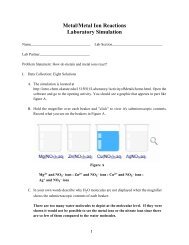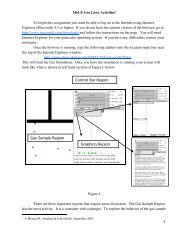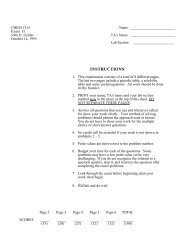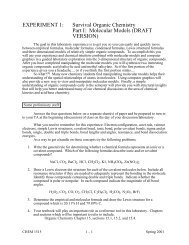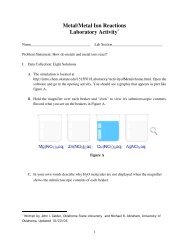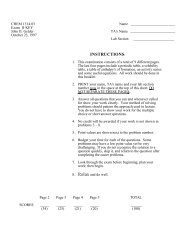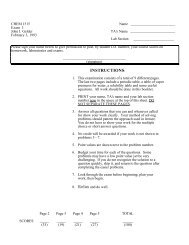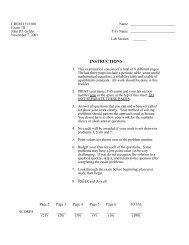11/9/00 1 Sample Multiple Choice Questions 11. Consider the ...
11/9/00 1 Sample Multiple Choice Questions 11. Consider the ...
11/9/00 1 Sample Multiple Choice Questions 11. Consider the ...
You also want an ePaper? Increase the reach of your titles
YUMPU automatically turns print PDFs into web optimized ePapers that Google loves.
<strong>Sample</strong> <strong>Multiple</strong> <strong>Choice</strong> <strong>Questions</strong><br />
<strong>11</strong>. <strong>Consider</strong> <strong>the</strong> reaction: H 2 (g) + I 2 (g) → 2 HI (g). Which of <strong>the</strong> following is<br />
true.<br />
A) ∆H˚ is negative, and ∆H˚ = ∆E˚<br />
B) ∆H˚ is positive, and ∆H˚ = ∆E˚<br />
C) ∆H˚ is negative, and ∆H˚ ≠ ∆E˚<br />
D) ∆H˚ is positive, and ∆H˚ ≠ ∆E˚<br />
E) ∆H˚rxn = ∆H˚f (HI (g))<br />
13. The heat of combustion of one mole of solid napthalene (C 10 H 8 ) to liquid water<br />
and gaseous carbon dioxide is -5162 kJ. Calculate <strong>the</strong> standard heat of<br />
formation of napthalene.<br />
A) 1.02 x 10 4 kJ/mol<br />
B) 2051 kJ/mol<br />
C) 259 kJ/mol<br />
D) 84 kJ/mol<br />
E) -168 kJ/mol<br />
12. Which of <strong>the</strong> following reactions is not exo<strong>the</strong>rmic<br />
A) 2H 2 (g) + O 2 (g) → 2H 2 O(g)<br />
B) Ba(OH) 2·8H 2 O(s) + 2NH 4 Cl(s) → BaCl 2 (aq) + 10H 2 O(l) + 2NH 3 (aq)<br />
C) HCl(aq) + NaOH(aq) → NaCl(aq) + H 2 O(l)<br />
D) 2C 4 H 10 (g) + 13O 2 (g) → 8CO 2 (g) + 10H 2 O(g)<br />
E) Al(s) + Br 2 (l) → AlBr 3 (s)<br />
13. The addition of 3.31 kJ of heat to a 3<strong>00</strong>. g sample of mercury at 19.0 ˚C caused<br />
<strong>the</strong> temperature to rise to 99.0 ˚C. What is <strong>the</strong> specific heat of mercury<br />
J<br />
A) 41.4 g·˚C<br />
J<br />
B) 7.25 g·˚C<br />
J<br />
C) 0.581 g·˚C<br />
J<br />
D) 0.138 g·˚C<br />
J<br />
E) 0.<strong>11</strong>1 g·˚C<br />
<strong>11</strong>/9/<strong>00</strong> 1
14. Which of <strong>the</strong> following equations is an example of a standard formation<br />
reaction<br />
A) Ca(s) + CO(g) + O 2 (g) → CaCO 3 (s)<br />
B) HgO(s) → Hg(l) + O 2 (g)<br />
C) 2C(s) + O 2 (g) → 2CO(g)<br />
D) 2Cl(g) → Cl 2 (g)<br />
E) Cl 2 (g) + 1 2 O 2 (g) → Cl 2 O(g)<br />
15. For which of <strong>the</strong> following reactions is ∆E = ∆H<br />
A) HgO(s) → Hg(l) + O 2 (g)<br />
B) H 2 (g) + Cl 2 (g) → 2HCl(g)<br />
C) 2NH 4 Cl(s) → N 2 (g) + 4H 2 (g) + Cl 2 (g)<br />
D) N 2 (g) + 2O 2 (g) → 2NO 2 (g)<br />
E) CH 4 (g) + 2O 2 (g) → CO 2 (g) + 2H 2 O(l)<br />
9. Which of <strong>the</strong> following elements has <strong>the</strong> largest ionization energy<br />
A) O<br />
B) B<br />
C) I<br />
D) Cs<br />
E) S<br />
10. Which of <strong>the</strong> following is isoelectronic with Ba 2+ <br />
A) Ca 2+<br />
B) La 2+<br />
C) O 2–<br />
D) I –<br />
E) Rn<br />
<strong>11</strong>. Which of <strong>the</strong> following has <strong>the</strong> smallest radius<br />
A) N<br />
B) B<br />
C) Al<br />
D) Be<br />
E) C<br />
<strong>11</strong>/9/<strong>00</strong> 2
13. A possible set of quantum numbers for <strong>the</strong> last electron added to complete <strong>the</strong><br />
ground state electron configuration for a neutral zinc atom is,<br />
n l m l m s<br />
A) 3 2 +2 - 1 2<br />
B) 4 1 -1 - 1 2<br />
C) 3 1 0 + 1 2<br />
D) 4 3 0 + 1 2<br />
E) 4 2 -2 + 1 2<br />
15. An atom of <strong>the</strong> element X has <strong>the</strong> electron configuration<br />
1s 2 2s 2 2p 6 3s 2 3p 3<br />
The compound most likely to form with Br is,<br />
A) XBr<br />
B) XBr 2<br />
C) X 2 Br 3<br />
D) XBr 3<br />
E) X 3 Br 2<br />
16. What is <strong>the</strong> electron configuration of a Co 3+ ion<br />
A) [Ar]4d 6<br />
B) [Ar]3d 6<br />
C) [Ar]4s 2 3d 10<br />
D) [Ar]4s 2 3d 4<br />
E) [Ar]4s 2 3d 7<br />
<strong>11</strong>/9/<strong>00</strong> 3




